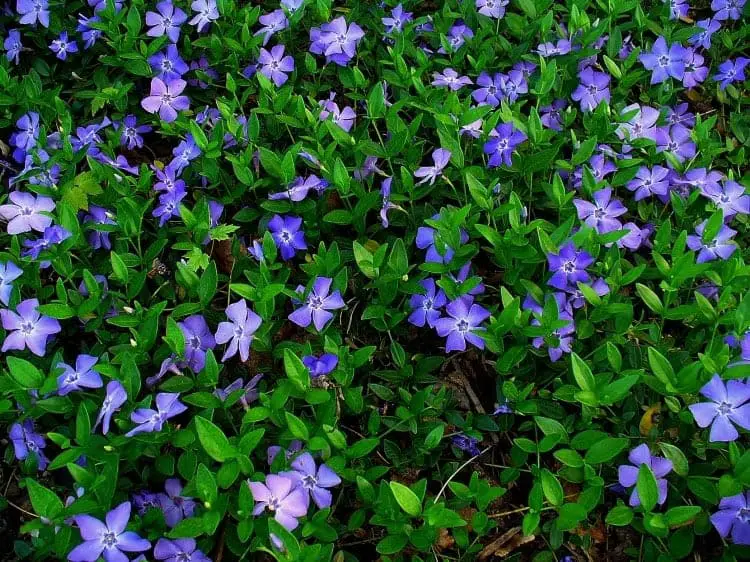Introduction
When it comes to landscaping and gardening, choosing the right ground cover plant can significantly enhance the aesthetic appeal and functionality of your garden. Among the myriad options available, Creeping Myrtle, also known as Vinca minor or Periwinkle, stands out as an exceptional choice. Its lush green foliage, charming blue-violet flowers, and low-maintenance nature make it an ideal ground cover plant for various settings. In this article, we will delve into the reasons why Creeping Myrtle is the perfect ground cover plant, exploring its characteristics, benefits, and care requirements.
Characteristics of Creeping Myrtle
Creeping Myrtle, scientifically known as Vinca minor, is a hardy evergreen perennial that belongs to the Apocynaceae family. It is native to Europe and parts of Asia but has become widely naturalized in many regions due to its adaptability and versatility. This plant is characterized by its trailing stems that root at the nodes, forming a dense mat of foliage that spreads rapidly. The leaves are glossy, dark green, and oval-shaped, providing a rich and vibrant ground cover throughout the year.
One of the most striking features of Creeping Myrtle is its delicate, star-shaped flowers. Typically blooming in early spring, the flowers are usually a shade of blue-violet, although white and pink varieties also exist. These flowers add a splash of color to the landscape and attract pollinators such as bees and butterflies, contributing to the ecological health of your garden.
Benefits of Using Creeping Myrtle as Ground Cover
- Erosion Control: One of the primary benefits of using Creeping Myrtle as a ground cover is its ability to control soil erosion. Its dense network of roots helps stabilize the soil, preventing erosion on slopes and hillsides. This makes it an excellent choice for areas prone to erosion and runoff.
- Low Maintenance: Creeping Myrtle is renowned for its low-maintenance nature. Once established, it requires minimal care and attention. It is drought-tolerant and can thrive in a variety of soil conditions, including poor and rocky soils. This resilience makes it an ideal choice for gardeners who prefer low-maintenance landscaping options.
- Weed Suppression: The dense mat of foliage created by Creeping Myrtle effectively suppresses weed growth. By covering the ground, it deprives weeds of the light and space they need to grow, reducing the need for frequent weeding and the use of herbicides.
- Aesthetic Appeal: The lush, evergreen foliage of Creeping Myrtle provides year-round visual interest. Its vibrant green leaves and charming blue-violet flowers create a picturesque ground cover that enhances the beauty of any garden or landscape. Additionally, it pairs well with other plants and flowers, adding depth and contrast to garden beds and borders.
- Adaptability: Creeping Myrtle is highly adaptable and can thrive in a variety of conditions. It grows well in both full sun and partial shade, making it suitable for different parts of the garden. Its tolerance to varying soil types and conditions further adds to its versatility as a ground cover plant.
How to Plant and Care for Creeping Myrtle
Planting
Planting Creeping Myrtle is a straightforward process. It can be propagated through seeds, cuttings, or by dividing established plants. For optimal results, follow these steps:
- Site Selection: Choose a location that receives partial shade to full sun. While Creeping Myrtle can tolerate full sun, partial shade is ideal for preventing the soil from drying out too quickly.
- Soil Preparation: Prepare the soil by loosening it to a depth of about 6 inches. Incorporate organic matter, such as compost, to improve soil fertility and drainage.
- Planting: Space the plants about 12 to 18 inches apart to allow room for their spreading habit. Dig holes that are slightly larger than the root balls and place the plants in the holes, ensuring that the crown is level with the soil surface. Backfill with soil and water thoroughly.
Care
Caring for Creeping Myrtle is relatively easy, thanks to its hardy nature. Here are some tips to ensure healthy growth:
- Watering: Water the plants regularly during the first growing season to establish a strong root system. Once established, Creeping Myrtle is drought-tolerant and only needs occasional watering during dry periods.
- Mulching: Apply a layer of mulch around the plants to conserve moisture, suppress weeds, and regulate soil temperature. Mulching also enhances the overall appearance of the planting area.
- Pruning: Prune Creeping Myrtle as needed to control its spread and maintain a tidy appearance. Regular pruning helps promote healthy growth and encourages more prolific flowering.
- Fertilizing: Fertilize the plants in early spring with a balanced, slow-release fertilizer to support vigorous growth and flowering. Avoid excessive fertilization, as it can lead to leggy growth and reduced flowering.
- Pest and Disease Control: Creeping Myrtle is generally resistant to pests and diseases. However, keep an eye out for common garden pests such as aphids and spider mites. If infestations occur, treat them with insecticidal soap or neem oil.
Conclusion
Incorporating Creeping Myrtle into your garden design offers numerous benefits, from erosion control and weed suppression to aesthetic appeal and low maintenance. Its adaptability and hardiness make it a reliable choice for various landscaping needs. Whether you are looking to cover a slope, fill in a shady area, or add a splash of color to your garden, Creeping Myrtle proves to be the perfect ground cover plant. With minimal care and attention, this charming plant will provide you with a beautiful and resilient ground cover for years to come.


